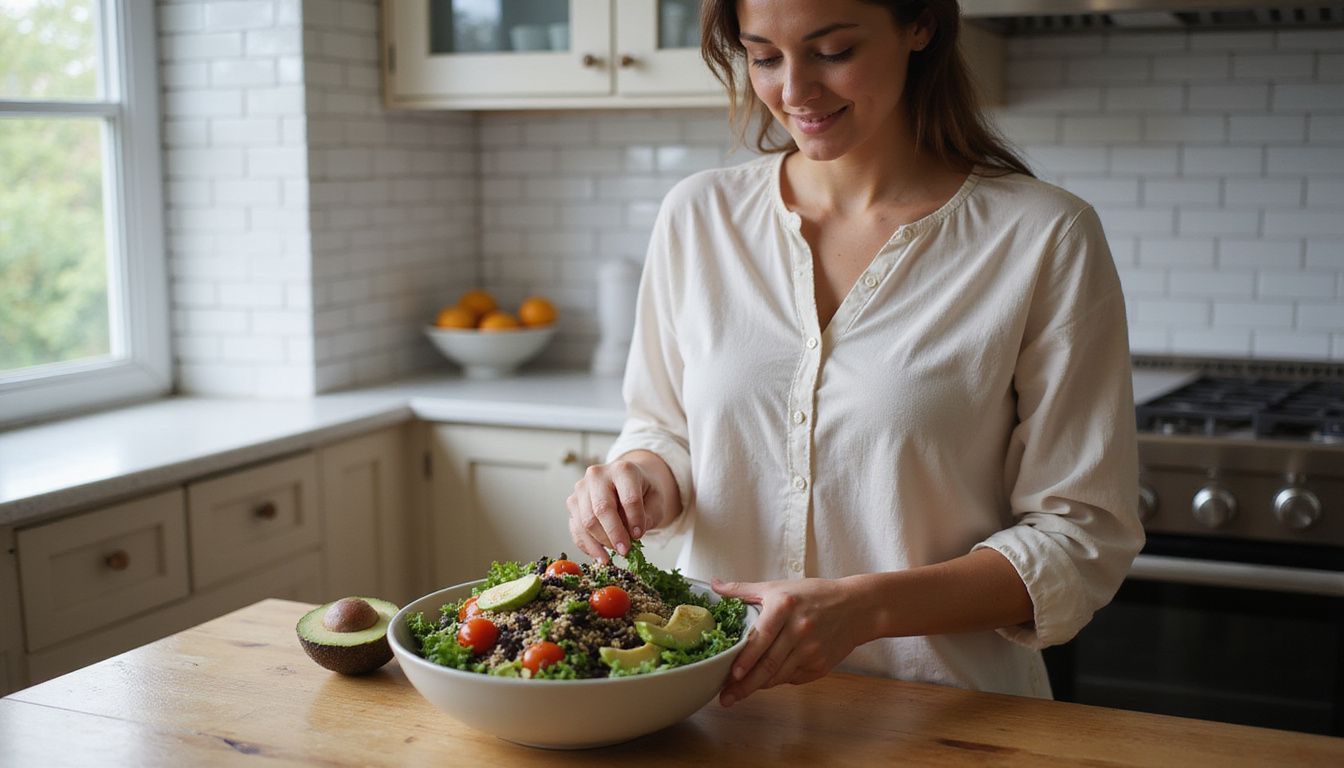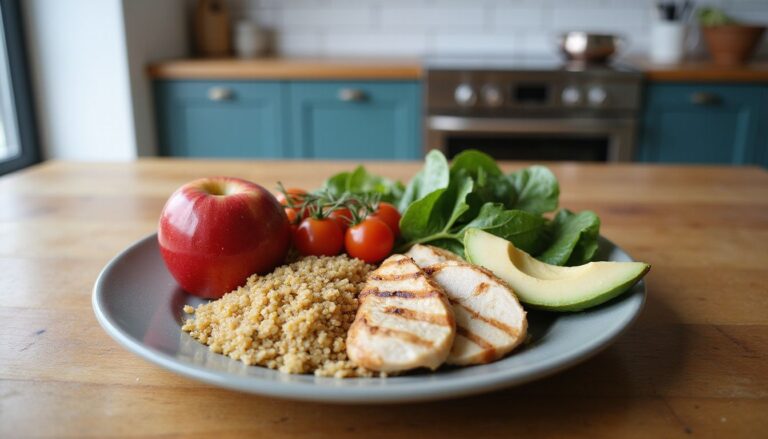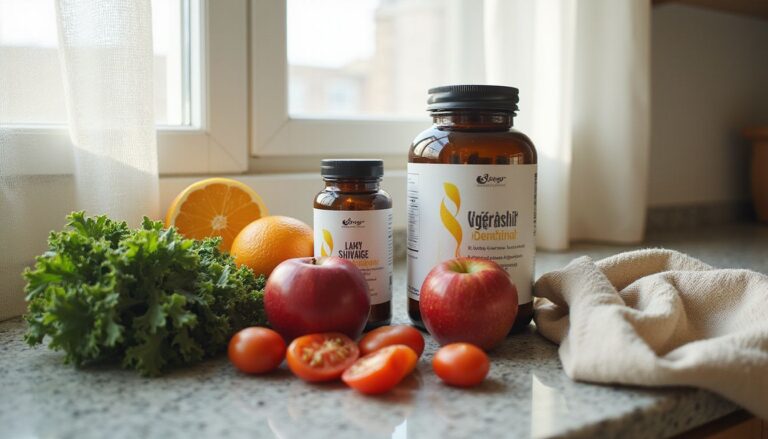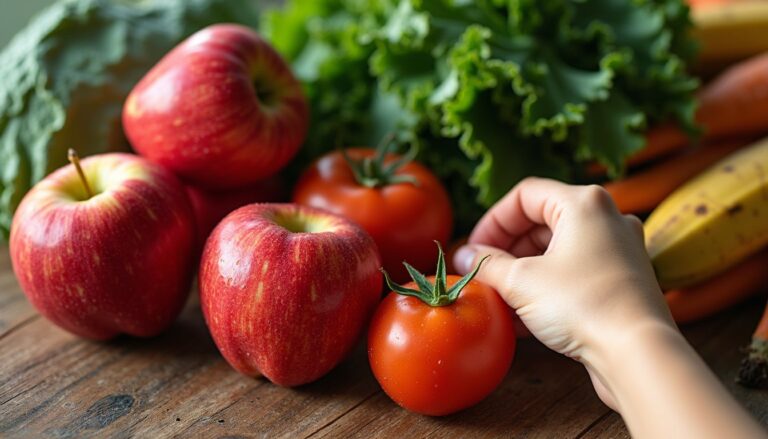Maximize Weight Loss Efforts With High Fiber Diet
Our Nutrition Assistant AI Suite will transform your body. You will lose fat, get toned, and build muscle. Gain confidence and optimal health.
If you struggle to lose weight or control hunger, you are not alone. A high-fiber diet can help you feel satisfied while eating fewer calories, which makes it easier to stick with your plan.
Most adults in the United States get only 10 to 15 grams of fiber per day. Experts recommend far more. In this guide, you will see how eating more fruits, vegetables, whole grains, beans, and seeds supports steady progress and better health.
You will also get simple ways to add fiber-rich foods to every meal without losing flavor or satisfaction. Start with one small change today.
Key Takeaways
- Most Americans eat only 10 to 15 grams of fiber daily, while the Dietary Guidelines for Americans 2020 to 2025 suggest 25 to 38 grams for adults.
- High-fiber foods increase fullness, slow digestion, and can reduce total calorie intake by about 10 percent compared with low-fiber diets.
- Eating fiber-rich foods, like beans, whole grains, fruits, nuts, and seeds, helps stabilize blood sugar and lowers the risk of type 2 diabetes and heart disease.
- Raise fiber gradually and drink more water to limit bloating or constipation as your body adjusts.
- Studies from the Academy of Nutrition and Dietetics report that intakes of at least 19 grams of fiber per day keep hunger away longer than lower intakes. [1][2]
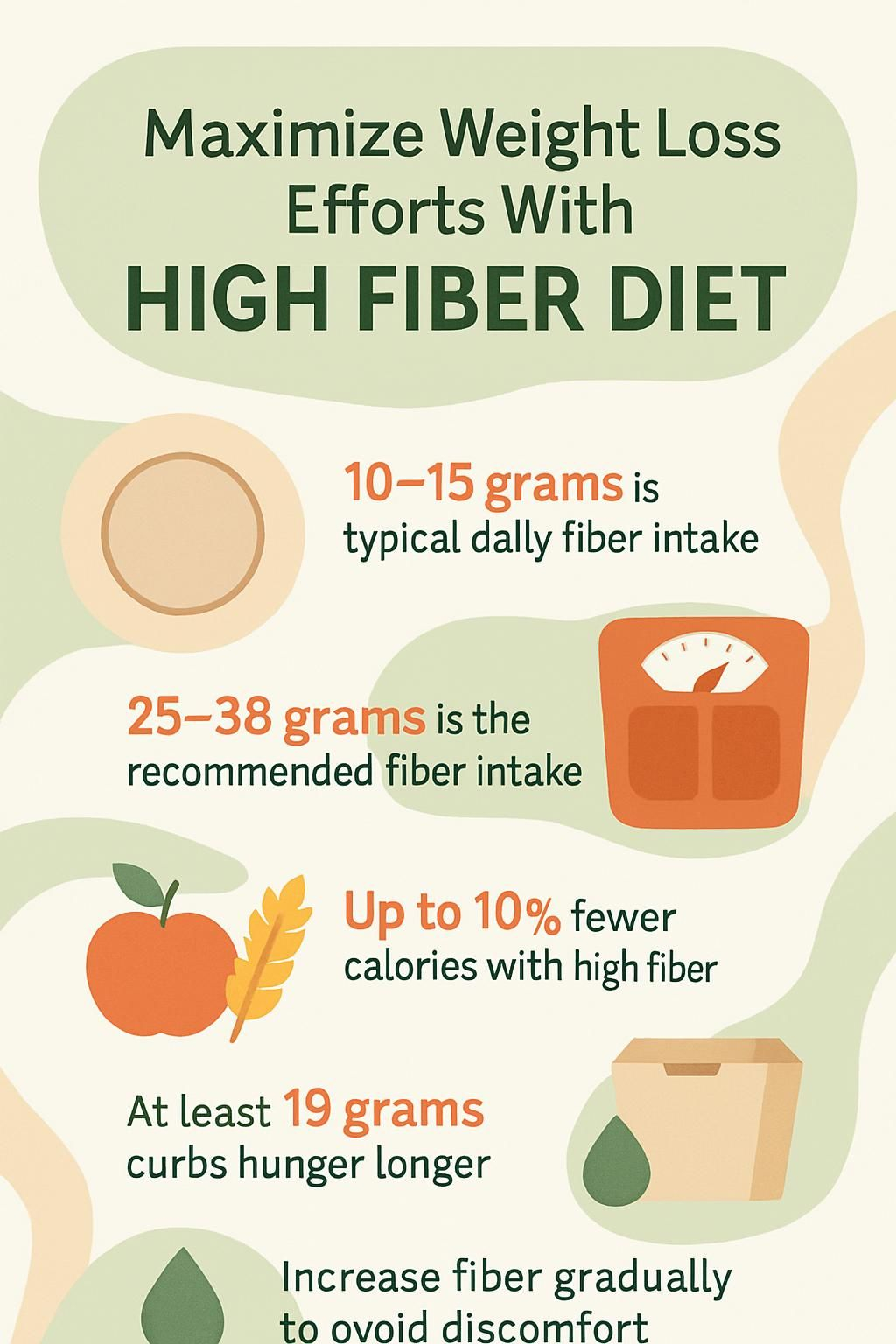
How Fiber Supports Weight Loss

Think of fiber as slow-release fuel for your appetite and energy. It nudges you to eat less without feeling deprived.
How does fiber increase feelings of fullness?
Soluble fiber dissolves in water to form a gel in your gut. Insoluble fiber adds bulk to food. Both slow emptying of the stomach, so you stay satisfied longer between meals.
High-fiber foods, such as fruits, vegetables, beans, and whole grains, require more chewing. That extra chewing gives your brain time to sense fullness. Fiber also adds volume without many calories, so you can enjoy bigger portions while limiting calories.
In a study from the Academy of Nutrition and Dietetics, people who ate 19 grams of fiber a day felt full longer than those who ate less. After switching white bread for whole wheat toast, or adding chickpeas to a salad, many people notice fewer mid-afternoon snacks.
“Eating enough fiber keeps hunger away, so you do not keep looking for more snacks.”
What impact does fiber have on digestion and metabolism?
Once you feel full, fiber keeps helping. It slows how fast food moves through your gastrointestinal tract. Your body gets more time to absorb nutrients while you take in fewer calories from high-fiber foods.
Enough dietary fiber also supports gut bacteria. These microbes make short-chain fatty acids, which may improve fat storage signals and how many calories you burn at rest.
A daily mix of fruits, vegetables, whole grains, nuts, and legumes, like lentils or soybeans, makes it easier to reach the recommended 25 to 38 grams of fiber per day in the Dietary Guidelines for Americans.
Over time, higher fiber intake improves digestion and appetite control, which supports a healthy weight.
How does fiber help regulate blood sugar levels?
Fiber slows how fast sugars enter your blood. This steadier rise helps prevent spikes and crashes that drive cravings and overeating.
Foods like oatmeal, berries, whole grains, chia seeds, flaxseed, apples, and bran help control how fast carbohydrates reach your bloodstream. Many dietitians suggest pairing fiber with protein or healthy fat to further steady blood sugar.
Stable blood sugar also supports heart health and can lower the risk of obesity, according to the American Heart Association.
Types of Fiber and Their Benefits
There are two main types of fiber, and both matter for weight loss and gut health. Knowing good sources helps you hit your daily target with ease.
What are the benefits of soluble fiber?
Soluble fiber dissolves in water and forms a gel-like substance in your gut. It slows digestion, boosts fullness, and helps regulate blood sugar. You get fewer spikes, fewer crashes, and fewer cravings.
Soluble fiber also binds to cholesterol in the digestive tract. That helps remove it from your body, which supports heart health. Oats, beans, lentils, apples, and pears are strong choices.
Try oatmeal for breakfast or add 1 cup of low-fat plain yogurt with berries as a snack. Many experts link higher soluble fiber intake with better appetite control and lower cardiovascular risk.
What are the benefits of insoluble fiber?
Insoluble fiber adds bulk to stool and helps it move through your large intestine. It reduces constipation and supports regularity.
Foods rich in insoluble fiber include whole grains, vegetables, and nuts like walnuts or peanuts, plus seeds. Eating enough may also lower the risk of colon cancer over time.
Add quinoa to dinner or enjoy raw carrots with peanut butter. These options raise fiber without many extra calories and can make weight loss feel easier.
Which foods are high in fiber?
Here are handy choices you can add to meals and snacks. They make it easier to reach your daily goal while helping with weight control.
- Split peas provide 16 grams of fiber per cooked cup. Stir them into soups for a quick boost.
- Lentils supply 15.5 grams per boiled cup. Use them in salads or grain bowls.
- Black beans offer 15 grams per boiled cup. Add to chili or burritos for steady energy.
- Raspberries give 8 grams per cup. Top cereal or blend into smoothies.
- Green peas contain 9 grams per cooked cup. Toss into pasta or rice bowls.
- Chia seeds pack 10 grams per ounce. Mix into yogurt, oatmeal, or smoothies.
- Whole-wheat spaghetti delivers 6 grams per cooked cup. Choose whole grains to manage hunger.
- Avocado adds fiber and healthy fats. Slice onto toast, salads, or blend into a smoothie.
- Nuts like almonds and walnuts supply fiber and protein. A small handful curbs cravings.
Including these foods helps regulate blood sugar, supports cardiovascular health, improves digestion, and keeps your plan simple and satisfying.
Benefits of a Fiber-Rich Diet for Weight Loss
Fiber helps you feel full, manage hunger, and stick with your goals. Think of it as a steady hand on your appetite.
How does fiber enhance fullness?
Fiber absorbs water, expands, and adds bulk to food. Digestion takes longer, and your brain gets a clear signal that you have eaten enough.
People who eat more fiber report greater satiety. Many experts recommend at least 25 grams per day for women and 38 grams for men. Beans, berries, whole grains, nuts, and seeds make meeting those targets easier.
How does fiber help reduce calorie intake?
High-fiber foods fill you up for fewer calories. They also take longer to chew, which slows you down and helps you notice fullness.
Digestion of fiber-rich meals burns a bit more energy, called the thermic effect of food. People eating higher fiber often consume around 10 percent fewer daily calories than those with lower fiber diets.
Soluble fiber forms a gel in your stomach and slows emptying. That keeps you satisfied for hours and makes overeating less likely.
Can fiber reduce cravings and overeating?
Yes. Steady blood sugar means fewer sudden hunger spikes, so snacking loses its pull. A bowl of oatmeal with berries, for example, holds you longer than a sugary cereal.
Many people feel fewer urges to snack between meals when they reach 25 to 30 grams of dietary fiber each day.
How does fiber support digestive health?
Fiber helps stool hold water, which makes it softer and easier to pass. That supports regular bowel movements and reduces constipation.
Fiber also feeds helpful gut bacteria. These organisms create short-chain fatty acids that support the lining of your colon. Research shows that people who meet daily fiber goals report fewer digestive problems.
As you add more beans, seeds, whole grains, and berries, drink enough water so fiber can do its job well.
Best High-Fiber Foods for Weight Loss
Smart, high-fiber choices support weight loss and better health. Add these foods to meals you already enjoy.
What fiber-rich fruits aid weight loss?
Fruits deliver fiber plus natural sweetness. They help control hunger and support healthy digestion.
- Pears have 5.5 grams in one medium fruit. Their soluble fiber supports fullness and blood sugar control.
- Apples with skin contain 4.5 grams per medium apple. Most fiber sits in the peel.
- Bananas supply about 3 grams per medium fruit. They are easy to add to breakfast or snacks.
- Oranges offer about 3 grams each. They fill you up with few calories.
- Strawberries deliver about 3 grams per cup, along with vitamin C and potassium.
- Raspberries provide close to 8 grams per cup. Great for satiety and cravings.
- Blackberries contain about 7 grams per cup and support digestive health.
Vegetables can push your fiber even higher. See strong picks below.
Which vegetables are high in fiber?
Vegetables add volume, texture, and nutrients with very few calories. These options make meals more filling.
- Broccoli, boiled, one cup, gives 5 grams of fiber.
- Turnip greens, boiled, one cup, provide 5 grams.
- Brussels sprouts, cooked, one cup, deliver 4.5 grams.
- A medium baked potato with skin contains 4 grams, so keep the skin.
- Sweet corn, boiled, one cup, provides 4 grams.
- Cauliflower, raw, one cup, has 2 grams and works well in salads.
- A medium raw carrot adds about 1.5 grams and helps with fullness between meals.
Rotating these vegetables helps balance your diet and makes hunger easier to manage.
What whole grains support weight loss?
Whole grains include the entire grain kernel. They offer more fiber, which supports blood sugar control and lasting energy.
- Barley, pearled and cooked, 6.0 grams per cup. It helps reduce cravings.
- Bran flakes, 5.5 grams in 3/4 cup. A quick breakfast or snack.
- Quinoa, 5.0 grams per cooked cup. It also supplies protein.
- Oat bran muffins, about 5.0 grams each. Helpful for regularity.
- Oatmeal, instant and cooked, 4.0 grams per cup. Steady morning energy.
- Popcorn, air-popped, 3.5 grams in three cups. Light and filling.
- Brown rice, 3.5 grams per cooked cup. A versatile base for bowls.
- Whole-wheat bread, 2.0 grams per slice. Pair with lean protein.
- Rye bread, about 2.0 grams per slice. Adds variety to sandwiches.
Choosing whole grains over refined grains helps you feel satisfied and limits extra calories.
How do legumes benefit weight loss?
Legumes are nutrient-dense and budget-friendly. They deliver fiber and protein together, which improves fullness and supports weight control.
- Beans, lentils, and chickpeas help you stay full longer after meals.
- One cup of canned beans, like navy or great northern, has about 13 grams of fiber.
- High-fiber legumes slow digestion, which helps prevent sharp blood sugar spikes.
- Feeling satisfied with less food can lower daily calorie intake.
- Adding lentils or chickpeas reduces cravings for processed snacks.
- Legumes support regularity and overall digestive comfort.
- Frequent legume intake supports heart health and may reduce hypertension risk.
- Using legumes daily builds healthy habits without relying on supplements.
Which nuts and seeds add fiber?
Nuts and seeds are small but mighty. They add fiber, healthy fats, and crunch, which makes meals more satisfying.
- Almonds offer 3.5 grams of fiber per 1-ounce serving, about 23 nuts.
- Chia seeds provide 10 grams per 1-ounce serving. Stir them into yogurt or smoothies.
- Walnuts contain about 2 grams in eight halves. Add to salads for extra texture.
- Flaxseeds add fiber and omega-3 fats. Grind and mix into oatmeal for steady energy.
- Pumpkin seeds supply roughly 1 gram per ounce. Use as a topping for bowls or soups.
- Sunflower seeds contain nearly 3 grams per ounce. Great in homemade trail mix.
Mixing several types across the week supports fullness and better blood sugar control.
How Much Fiber Should You Eat?
Most adults do not get enough fiber to support a healthy weight and comfortable digestion. Knowing your target makes planning easier.
What are the fiber intake guidelines for men and women?
Use these goals from the 2020 to 2025 Dietary Guidelines for Americans as a starting point. The typical recommendation is 14 grams of fiber per 1,000 calories.
| Age Group | Recommended Fiber Intake (grams/day) | Notes |
|---|---|---|
| Men (ages 19-50) | 38 | 14 grams per 1,000 calories consumed |
| Men (ages 51+) | 30 | Energy needs decrease with age |
| Women (ages 19-50) | 25 | 14 grams per 1,000 calories consumed |
| Women (ages 51+) | 21 | Lower energy requirements in older adults |
| Children (ages 2+) | 14 grams per 1,000 calories | Applies to both boys and girls |
| Children (12–23 months) | 19 | Special guideline for toddlers |
- Common target: about 28 grams per day for adults eating 2,000 calories.
- Fiber supports weight management, digestive function, and heart health.
- Meeting these targets helps regulate blood sugar and improves satiety.
How can you safely increase your fiber intake?
Raise fiber slowly and pair it with more water. Your gut needs time to adapt to higher fiber levels.
- Increase fiber over several days to limit gas, cramping, or bloating.
- Drink enough water so fiber can soften stool and prevent constipation.
- Add one new high-fiber food per meal, like berries at breakfast or whole grain bread at lunch.
- Choose whole foods over supplements for fiber plus vitamins and minerals.
- Check nutrition labels and compare fiber per serving.
- Blend in small amounts, like stirring ground flaxseed into yogurt or adding beans to soup.
- Speak with a registered dietitian or healthcare professional if you have special dietary needs.
These steps help you increase fiber without discomfort, which makes the habit stick.
High-Fiber Meal Ideas for Weight Loss
High-fiber meals keep you full and support steady progress. A little planning goes a long way.
What are some high-fiber breakfast options?
Start strong. Breakfast sets the tone for your appetite and energy all day.
- Oatmeal with berries and a handful of nuts. It steadies blood sugar and keeps you full.
- Apple Cinnamon Chia Pudding, 10 grams of fiber and about 233 calories. Prep it the night before.
- Baked Banana-Nut Oatmeal Cups, 3 grams of fiber and about 176 calories per serving. Easy on busy mornings.
- Really Green Smoothie, 12 grams of fiber and about 343 calories, packed with leafy greens, fruit, and seeds.
- Whole grain toast with nut butter and sliced banana for a fast boost of fiber.
- Greek yogurt mixed with high-fiber cereal or chia or flaxseeds for protein and roughage.
- Breakfast burritos in whole wheat tortillas with beans, vegetables, and salsa for a savory start.
When I swapped refined cereal for oatmeal with berries and nuts, my mid-morning cravings dropped within two weeks.
What fiber-rich lunches can you try?
Make lunch work for you. Combine whole foods for fiber, protein, and color.
- White Bean and Avocado Toast, about 314 calories and 16 grams of fiber per serving.
- Brussels Sprouts Salad with Crunchy Chickpeas, about 337 calories and 13 grams of fiber.
- Add a small pear to any lunch for 5.5 grams of fiber.
- Salad with mixed greens, black beans, peppers, corn, and sliced avocado.
- Whole grain wrap with hummus, shredded carrots, spinach, and kidney beans.
- Quinoa with roasted sweet potato, kale, pumpkin seeds, and dried cranberries.
- Top salads or wraps with raspberries or blackberries. One cup can add more than 8 grams of fiber.
Quick options like these make afternoon cravings far less likely.
What are nutritious high-fiber dinner ideas?
End the day with meals that fill you up, not out. These dinners bring flavor and fiber together.
- Roasted Chicken and Winter Squash over Mixed Greens, 7 grams of fiber and about 415 calories.
- Hearty Chickpea and Spinach Stew, 13 grams of fiber and about 401 calories.
- Chicken Fajita Bowls with guacamole, 15 grams of fiber and about 446 calories.
- Long-Life Noodles with Beef and Chinese Broccoli, 8 grams of fiber and about 449 calories.
- Slow-Cooker Turkey Chili with Butternut Squash, about 17 grams of fiber per serving when paired with greens and avocado.
- Add berries to salads or use as a whole grain topping for extra fiber and color.
- Include lentils or black beans in soups, stews, or salads to raise fiber and protein.
These choices help control hunger, steady blood sugar, and reduce late-night snacking.
Which snacks can boost fiber intake?
High-fiber snacks bridge the gap between meals. They steady energy and curb cravings.
- A small apple, about 77 calories and 3 to 4 grams of fiber.
- A clementine, about 35 calories and 1 gram of fiber.
- Twenty almonds, about 154 calories and 3 grams of fiber.
- Eight walnut halves, about 105 calories and 2 grams of fiber.
- Berries such as raspberries or blackberries, fiber-rich with few calories.
- Roasted chickpeas, crunchy with protein and fiber.
- Air-popped popcorn, low in calories and high in volume and fiber.
- One-third cup dry-roasted unsalted almonds for extra energy and fiber.
Plan snacks ahead, and your afternoon will feel much easier.
Easy Ways to Add More Fiber to Your Diet
Small daily tweaks can raise your fiber intake a lot. Simple habits add up fast.
How can you combine fiber with proteins and fats?
Pair fiber with protein and healthy fats for staying power. Try oatmeal with nuts or seeds at breakfast. At lunch, add beans or lentils with sliced avocado or chopped walnuts.
Olive oil over roasted vegetables helps your body absorb vitamins better. A bowl of black bean chili topped with avocado can keep you satisfied for hours.
Why choose whole grains over refined grains?
Whole grains, like brown rice, quinoa, and oatmeal, include more fiber than refined grains. Your body works harder to digest them, which burns a bit more energy and helps you feel full longer.
For example, one cup of cooked brown rice has about 3.5 grams of fiber. White rice has less than 1 gram. Whole grains also keep more vitamins and minerals that support weight control and health.
How to increase fruits and vegetables in meals?
Add fresh or frozen fruit to cereal, yogurt, or oatmeal. Use berries in smoothies or as a topping for whole grain pancakes. Stir chopped vegetables into eggs, soups, and stews.
At lunch and dinner, fill at least half your plate with vegetables like spinach, broccoli, carrots, peppers, or cauliflower. Snack on raw vegetable sticks instead of chips. Choose fresh fruit over dried fruit to get more fiber per serving with less sugar.
The USDA suggests aiming for 2 cups of fruit and 2 to 3 cups of vegetables daily. Frozen produce works well and reduces waste.
How to include nuts, seeds, and legumes?
Sprinkle chia seeds, almonds, or walnuts over oatmeal or yogurt. Add beans or chickpeas to salads and soups for a filling boost. Use lentils in stews, chili, or grain bowls for extra protein and complex carbs.
Choose unsalted nuts for healthy fats plus fiber. A small handful between meals can make cravings fade.
Common Fiber Diet Mistakes to Avoid
A few missteps can cause discomfort and derail good habits. Avoid these pitfalls to keep progress steady.
Why should you avoid increasing fiber too quickly?
Adding too much fiber at once can trigger gas, bloating, and cramping. Your gut needs time to adjust. Increase fiber in small steps, just a few grams per day, instead of making big jumps.
Slow changes make it easier to enjoy the benefits of fiber and stick with your plan.
How important is drinking enough water with fiber?
Water is essential with a high-fiber diet. Fiber needs fluid to swell and soften stool. Without enough water, higher fiber may lead to bloating or constipation.
Aim for at least eight cups of water per day, more with heat or exercise. Keeping a water bottle handy or blending a fruit-and-water smoothie can help you stay consistent.
Good hydration keeps digestion comfortable as you add more beans, seeds, and vegetables.
Why choose whole foods instead of supplements?
Whole foods deliver fiber plus vitamins, minerals, and antioxidants. You get all of these in fruits, vegetables, whole grains, nuts, and legumes, while fiber supplements provide isolated fiber only.
Whole foods also require chewing, which supports fullness. Many people feel more satisfied after an apple or a bowl of oatmeal than after a fiber drink.
Overall Health Benefits of a High-Fiber Diet
A high-fiber eating pattern supports digestion, heart health, and stable blood sugar. The benefits extend far beyond weight control.
How does fiber help prevent heart disease?
Soluble fiber helps lower cholesterol by binding to it in the digestive tract and removing it from the body. People who consume 25 to 30 grams of fiber per day tend to have lower rates of heart problems.
Focus on whole grains, fruits, vegetables, nuts, and seeds. Swapping white bread for whole grain options can help improve cholesterol levels over time.
Can fiber improve cholesterol levels?
Yes. Oats, beans, apples, and citrus fruits contain soluble fiber that targets LDL, or bad cholesterol. Eating 5 to 10 grams of soluble fiber per day may reduce LDL by up to five percent.
Including oatmeal at breakfast and beans at lunch can add up. Many national guidelines promote higher dietary fiber for better cholesterol numbers.
How does fiber help prevent type 2 diabetes?
Fiber slows sugar absorption and reduces blood glucose spikes after meals. That eases the demand on insulin and supports better control over time.
Diets rich in whole grains, legumes, fruits, and vegetables are linked with a lower risk of type 2 diabetes. Aim for 25 to 38 grams of fiber daily as part of a balanced plan.
What are fiber’s effects on colon health and cancer risk?
Soluble and insoluble fiber add bulk to stool and help waste move faster through the colon. That reduces contact time between the colon lining and potential toxins.
Populations eating higher fiber tend to have more diverse gut bacteria and lower rates of colorectal cancer. Regular fiber intake may help protect the colon by supporting a healthy gut environment and lowering inflammation.
Combining Fiber with Other Healthy Habits
Pair fiber with smart daily routines for stronger results. Small actions compound over time.
How does regular exercise complement fiber intake?
Exercise and fiber make a powerful team for weight management. Activity boosts metabolism, so you burn more calories through the day. Research from the Centers for Disease Control and Prevention shows adults who combine exercise with higher fiber are more likely to manage weight well. 1
Exercise also supports regular bowel movements, which helps fiber do its job. Most adults should aim for at least 150 minutes of moderate activity each week. 2
1. CDC.gov – “Physical Activity Basics”.
2. U.S Department of Health & Human Services – “Physical Activity Guidelines for Americans”.
Why is hydration important for digestive health?
Water helps fiber work as intended. It allows fiber to swell and form a soft, bulky stool that moves easily through your digestive tract.
If you add more whole grains and beans, increase fluids too. Many people feel better when they reach at least eight cups a day.
How to balance fiber with other essential nutrients?
Build meals around fiber, protein, and healthy fat. Pair beans or lentils with grilled chicken or tofu. Add avocado, olive oil, nuts, or seeds for better vitamin absorption and satiety.
Include colorful fruits and vegetables plus whole grains at each meal. Many adults do well with 25 to 38 grams of fiber a day, and a source of protein at every meal.
For example, top oatmeal with chia seeds and sliced almonds and have an egg on the side. At lunch or dinner, combine quinoa, roasted vegetables, and salmon drizzled with extra-virgin olive oil.
When to Consult a Dietitian About Fiber Intake
A registered dietitian can help you set goals, plan meals, and troubleshoot discomfort. Personalized guidance is helpful if you have medical conditions or complex needs.
How can a dietitian create custom meal plans for weight loss?
Dietitians assess your age, weight, activity level, health goals, preferences, and medical history. They set calorie targets, like 1,200, 1,500, or 2,000 calories per day, and include high-fiber foods at each meal while watching portions.
They review food diaries and adjust the plan based on results. Many people find they can meet both fiber and calorie goals without feeling deprived when they follow a clear, tailored plan.
When should you adjust fiber intake for individual needs?
If you have irritable bowel syndrome or a sensitive digestive system, increase fiber very slowly. If discomfort persists, ask a healthcare professional for guidance.
People with conditions like Crohn’s disease or diverticulitis may need special advice. Raising fiber in small steps, such as adding beans or whole grains a few times per week, often prevents stomach pain and makes the change easier.
This content is educational and not a substitute for medical advice. Talk with your clinician if you have questions about fiber and your health.
Conclusion
A high-fiber diet helps you eat fewer calories without feeling hungry. Filling your plate with fiber-rich foods, like fruits, vegetables, whole grains, and legumes, supports steady weight loss and better digestion.
Most adults do best with 25 to 38 grams of fiber per day, or about 14 grams per 1,000 calories. Drink plenty of water as you increase fiber, and add regular exercise for even stronger results.
Start with one change, such as oatmeal at breakfast or beans at lunch. Small steps add up. A consistent, high-fiber approach can help you reach your goals and support long-term health. [1][2]
FAQs
1. How does a high fiber diet help with weight loss?
A high fiber eating plan helps control hunger by making you feel full longer. Studies show that people who eat more dietary roughage tend to consume fewer calories throughout the day, which supports steady fat reduction efforts.
2. What are some good sources of dietary roughage for weight management?
Whole grains like oats and barley, legumes such as lentils and black beans, fruits including apples and pears, and vegetables like broccoli provide excellent amounts of dietary roughage. These foods also supply vitamins and minerals needed for overall health.
3. Are there any risks linked to increasing dietary roughage too quickly?
Raising your intake of plant-based bulk suddenly can cause stomach discomfort or gas in some individuals. Experts recommend adding these foods gradually while drinking enough water to support digestion.
4. Can I lose body mass faster if I only focus on eating more plant-based bulk?
Eating more plant-based bulk aids appetite control but works best when combined with regular exercise and balanced meals rich in protein and healthy fats. Research suggests that this approach leads to better long-term results than focusing on one nutrient alone.
Summary: A meal plan rich in whole grains, legumes, fruits, and vegetables provides plenty of dietary roughage that promotes fullness and supports steady fat reduction goals without major side effects when introduced slowly alongside other healthy habits.

